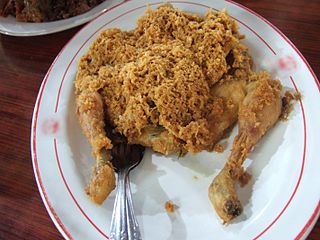
Minangkabau people, also known as Minang, are an ethnic group native to the Minangkabau Highlands of West Sumatra, Indonesia. The Minangkabau's West Sumatran homelands was the seat of the Pagaruyung Kingdom, believed by early historians to have been the cradle of the Malay race, and the location of the Padri War.

Minangkabau is an Austronesian language spoken by the Minangkabau of West Sumatra, the western part of Riau, South Aceh Regency, the northern part of Bengkulu and Jambi, also in several cities throughout Indonesia by migrated Minangkabau. The language is also a lingua franca along the western coastal region of the province of North Sumatra, and is even used in parts of Aceh, where the language is called Aneuk Jamee.

Pagaruyung Palace is the istana of the former Pagaruyung Kingdom, located in Tanjung Emas subdistrict near Batusangkar town, Tanah Datar Regency, West Sumatra, Indonesia. It was built in the traditional Minangkabau Rumah Gadang vernacular architectural style, but had a number of atypical elements including a three-story structure and a larger dimension in comparison to common rumah gadang.

Padang food or Minang food is the cuisine of the Minangkabau people of West Sumatra, Indonesia. It is among the most popular food in Maritime Southeast Asia. It is known across Indonesia as Masakan Padang after the city of Padang the capital city of West Sumatra province. It is served in restaurants mostly owned by perantauan (migrating) Minangkabau people in Indonesian cities. Padang food is ubiquitous in Indonesian cities and is popular in neighboring Malaysia and Singapore.

The Overseas Minangkabau is a demographic group of Minangkabau people of Minangkabau Highlands origin in West Sumatra, Indonesia who have settled in other parts of the world. Over half of the Minangkabau people can be considered overseas Minangkabaus. They make up the majority of the population of Negeri Sembilan and Pekanbaru. They also form a significant minority in the populations of Jakarta, Bandung, Medan, Batam, Surabaya and Palembang in Indonesia as well as Kuala Lumpur, Malacca, Penang, Singapore and Brunei Darussalam in the rest of the Malay world. Minangkabaus have also emigrated as skilled professionals and merchants to the Netherlands, United States, Saudi Arabia and Australia. The matrilineal culture and economic conditions in West Sumatra have made the Minangkabau people one of the most mobile ethnic group in Maritime Southeast Asia.

Jam Gadang is a clock tower, major landmark, and tourist attraction in the city of Bukittinggi, West Sumatra, Indonesia. It is in the centre of the city, near the main market, Pasar Ateh. It has large clocks on each face.

Abdul Karim Amrullah, known as Haji Rasul, was a Muslim reformer who led reformation of Islam in Sumatra, Dutch East Indies.

Nasi kapau is a Minang steamed rice topped with various choices of dishes originated from Nagari Kapau, Bukittinggi, a tourism and culinary hotspot town in West Sumatra, Indonesia. It is often describes as Minang version of nasi ramas or nasi campur.

Cnemaspis girii, also known as Giri's day gecko, is a species of geckos in the genus Cnemaspis described in 2014. The species, found in the forests of the Kaas plateau in Satara district, Maharashtra, India, was discovered by researchers from Bangalore's National Centre for Biological Sciences (NCBS) and Centre for Ecological Sciences (CES). The gecko lives under rocks and hollowed out trees near water bodies within its range.

Mineng, also spelled Minang or Menang or Mirnong, are an indigenous Noongar people of southern Western Australia.

Ayam goreng is an Indonesian and Malaysian dish consisting of chicken deep fried in oil. Ayam goreng literally means "fried chicken" in Malay and also in many Indonesian regional languages. Unlike the Southern United States-style fried chicken, this Southeast Asian version is neither coated in batter nor flour, but rather seasoned rich in various spices.
Cnemaspis kandambyi is a species of diurnal gecko endemic to island of Sri Lanka, described in 2017 from Knuckles Mountain Range.

Balado is a type of hot and spicy bumbu found in Minang cuisine of West Sumatra, Indonesia. Balado sauce is made by stir frying ground red hot chili pepper with other spices including garlic, shallot, tomato and key lime juice in coconut or palm oil.
Cnemaspis affinis, also known as Stoliczka's gecko or Pinang Island rock gecko, is a species of gecko endemic to Malaysia.

Cnemaspis argus, also known as the Argus rock gecko, Dring's gecko, or Lawit Mountain rock gecko, is a species of gecko endemic to western Malaysia.
Cnemaspis kumpoli, also known commonly as Kumpol's rock gecko or the Trang Province gecko, is a species of gecko, a lizard in the family Gekkonidae. The species is endemic to the Malay peninsula.
Cnemaspis australis, also known as the southern day gecko, is a species of gecko endemic to southern India.











